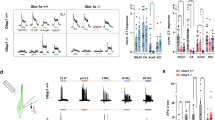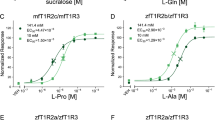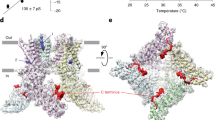Abstract
TRPM5, a cation channel of the TRP superfamily, is highly expressed in taste buds of the tongue, where it has a key role in the perception of sweet, umami and bitter tastes1,2. Activation of TRPM5 occurs downstream of the activation of G-protein-coupled taste receptors and is proposed to generate a depolarizing potential in the taste receptor cells2. Factors that modulate TRPM5 activity are therefore expected to influence taste. Here we show that TRPM5 is a highly temperature-sensitive, heat-activated channel: inward TRPM5 currents increase steeply at temperatures between 15 and 35 °C. TRPM4, a close homologue of TRPM5, shows similar temperature sensitivity. Heat activation is due to a temperature-dependent shift of the activation curve, in analogy to other thermosensitive TRP channels3. Moreover, we show that increasing temperature between 15 and 35 °C markedly enhances the gustatory nerve response to sweet compounds in wild-type but not in Trpm5 knockout mice. The strong temperature sensitivity of TRPM5 may underlie known effects of temperature on perceived taste in humans4,5,6, including enhanced sweetness perception at high temperatures and ‘thermal taste’, the phenomenon whereby heating or cooling of the tongue evoke sensations of taste in the absence of tastants7.
This is a preview of subscription content, access via your institution
Access options
Subscribe to this journal
Receive 51 print issues and online access
$199.00 per year
only $3.90 per issue
Buy this article
- Purchase on Springer Link
- Instant access to full article PDF
Prices may be subject to local taxes which are calculated during checkout




Similar content being viewed by others
References
Perez, C. A. et al. A transient receptor potential channel expressed in taste receptor cells. Nature Neurosci. 5, 1169–1176 (2002)
Zhang, Y. et al. Coding of sweet, bitter, and umami tastes: different receptor cells sharing similar signalling pathways. Cell 112, 293–301 (2003)
Voets, T. et al. The principle of temperature-dependent gating in cold- and heat-sensitive TRP channels. Nature 430, 748–754 (2004)
Bartoshuk, L. M., Rennert, K., Rodin, J. & Stevens, J. C. Effects of temperature on the perceived sweetness of sucrose. Physiol. Behav. 28, 905–910 (1982)
Green, B. G. & Frankmann, S. P. The effect of cooling on the perception of carbohydrate and intensive sweeteners. Physiol. Behav. 43, 515–519 (1988)
Green, B. G. & Frankmann, S. P. The effect of cooling the tongue on the perceived intensity of taste. Chem. Senses 12, 609–619 (1987)
Cruz, A. & Green, B. G. Thermal stimulation of taste. Nature 403, 889–892 (2000)
Clapham, D. E. TRP channels as cellular sensors. Nature 426, 517–524 (2003)
Patapoutian, A., Peier, A. M., Story, G. M. & Viswanath, V. ThermoTRP channels and beyond: mechanisms of temperature sensation. Nature Rev. Neurosci. 4, 529–539 (2003)
Patapoutian, A. TRP channels and thermosensation. Chem. Senses 30 (suppl. 1), i193–i194 (2005)
Hille, B. in Ion Channels of Excitable Membranes (ed. Hille, B.) Ch. 11, 366 (Sinauer Associates, Sunderland, 2001)
Liu, D. & Liman, E. R. Intracellular Ca2+ and the phospholipid PIP2 regulate the taste transduction ion channel TRPM5. Proc. Natl Acad. Sci. USA 100, 15160–15165 (2003)
Prawitt, D. et al. TRPM5 is a transient Ca2+-activated cation channel responding to rapid changes in [Ca2+]i . Proc. Natl Acad. Sci. USA 100, 15166–15171 (2003)
Ullrich, N. D. et al. Comparison of functional properties of the Ca2+-activated cation channels TRPM4 and TRPM5 from mice. Cell Calcium 37, 267–278 (2005)
Nilius, B. et al. Regulation of the Ca2+ sensitivity of the nonselective cation channel TRPM4. J. Biol. Chem. 280, 6423–6433 (2005)
van Lunteren, E., Elmslie, K. S. & Jones, S. W. Effects of temperature on calcium current of bullfrog sympathetic neurons. J. Physiol. Lond. 466, 81–93 (1993)
Tiwari, J. K. & Sikdar, S. K. Temperature-dependent conformational changes in a voltage-gated potassium channel. Eur. Biophys. J. 28, 338–345 (1999)
Correa, A. M., Bezanilla, F. & Latorre, R. Gating kinetics of batrachotoxin-modified Na+ channels in the squid giant axon. Voltage and temperature effects. Biophys. J. 61, 1332–1352 (1992)
Voets, T., Talavera, K., Owsianik, G. & Nilius, B. Sensing with TRP channels. Nature Chem. Biol. 1, 85–92 (2005)
Talavera, K., Janssens, A., Klugbauer, N., Droogmans, G. & Nilius, B. Extracellular Ca2+ modulates the effects of protons on gating and conduction properties of the T-type Ca2+ channel α1G (CaV3.1). J. Gen. Physiol. 121, 511–528 (2003)
Rong, M. et al. Signal transduction of umami taste: insights from knockout mice. Chem. Senses 30, i33–i34 (2005)
Kawai, K., Sugimoto, K., Nakashima, K., Miura, H. & Ninomiya, Y. Leptin as a modulator of sweet taste sensitivities in mice. Proc. Natl Acad. Sci. USA 97, 11044–11049 (2000)
Acknowledgements
We thank V. Flockerzi, R. Vennekens and U. Wissenbach for the TRPM4 clone; N. Ullrich, G. Owsianik and F. Mahieu for discussions; and R. Yoshida, A. Janssens and J. Prenen for technical assistance. This work was supported by grants from the Human Frontiers Science Program, the Belgian Federal Government (Interuniversity Poles of Attraction Program, Prime Ministers Office), the Flemish Government and the Onderzoeksraad KU Leuven, and the NIH (to R.F.M.) and by a Grant-in-Aid for scientific research from the Japan Society for the Promotion of Science (to Y.N. and to N.S.).
Author information
Authors and Affiliations
Corresponding author
Ethics declarations
Competing interests
R.F.M. has a personal financial interest in the form of stock ownership in the Linguagen company, receives consulting fees from the Linguagen company, and is an inventor on patents and patent applications which have been licensed to the Linguagen company.
Supplementary information
Supplementary Notes
This file contains Supplementary Figures 1–3 and their legends, and Supplementary Methods (Modelling the gating of TRPM4 and TRPM5). (DOC 2208 kb)
Rights and permissions
About this article
Cite this article
Talavera, K., Yasumatsu, K., Voets, T. et al. Heat activation of TRPM5 underlies thermal sensitivity of sweet taste. Nature 438, 1022–1025 (2005). https://doi.org/10.1038/nature04248
Received:
Accepted:
Published:
Issue Date:
DOI: https://doi.org/10.1038/nature04248
This article is cited by
-
TRPM channels in health and disease
Nature Reviews Nephrology (2024)
-
Thermoring basis for the TRPV3 bio-thermometer
Scientific Reports (2023)
-
TRP Channels in Stroke
Neuroscience Bulletin (2023)
-
Virtual taste: digital simulation of taste sensations via electric, thermal, and hybrid stimulations
Multimedia Tools and Applications (2023)
-
Physicochemical, antioxidant and sensory properties of Mango Sorbet containing L-theanine as a potential functional food product
Journal of Food Science and Technology (2022)
Comments
By submitting a comment you agree to abide by our Terms and Community Guidelines. If you find something abusive or that does not comply with our terms or guidelines please flag it as inappropriate.



